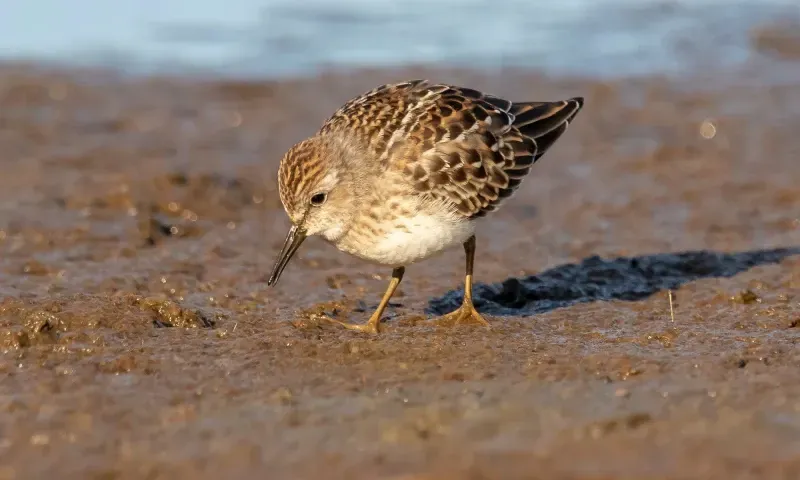Shorebirds of Southern Nevada

Shorebirds are truly impressive flyers – their bodies are sleek, their wings pointed and long. They move quickly and powerfully across the sky with fast, shallow wingbeats, propelled forward by powerful pectoral muscles. In 2022, one species of shorebird had its moment in the national news cycle as major newspapers picked up on impressive results from a study which tagged shorebirds called Bar-tailed Godwits. A few godwits in Alaska were captured by biologists, tagged with low-weight tracking beacons, and released. These birds breed in Alaska, but head down to New Zealand or Tasmania for the winter. Until birds could be tracked using modern, light-weight systems, no one could say for certain how long it takes for these migratory birds to get from one place to another, and which routes they take. But the results from the biologists’ tracking and reporting on their birds were newsworthy: one bird had flown from Alaska to New Zealand, flying across most of the Pacific Ocean, a route of more than 8,400 miles, in just eleven days. The bird was four months old.
Anyone who caught this news, even biologists and birders already paying attention to shorebirds, would have likely been impressed. But while the godwit may be a world superlative, we here in Nevada are also in luck, as our area plays host to its own impressive assemblage of long-distance athletes. To see them, you’ll need to visit the right habitats at the right time of year.
The word “shorebird” refers to a related group of bird families, and includes jacanas, avocets, stilts, plovers, and the richly diverse sandpipers. Some of the plovers and most of the sandpipers are long-distance migrants, meaning that their populations will cover vast amounts of ground throughout the year depending on the season. Yellowlegs breed in the spruce forests of Alaska and Canada and spend the winter in the southern states, Mexico, and tropical America. Western Sandpipers breed in open tundra in Alaska and then head to coastal Mexico. Long-billed Curlews breed in arid prairies across the west, but head to the Pacific and Gulf of Mexico to feed on crabs for the winter.
There are about fifty species of shorebirds whose populations can be found in North America at some point during the year. Some species rarely leave the coastlines of the Pacific or Atlantic, but most shorebirds that criss-cross the continent’s interior will show up in Nevada. When they do, most will assuredly be near water. Aside from the Killdeer and Long-billed Curlew, Nevada's shorebirds will need to locate a water source for finding food and security. Wetlands, pond and lake edges, and shallow flooded areas, like Ash Meadows NWR, Las Vegas Wash, and Henderson Bird Viewing Preserve, are the preferred stopover habitats for shorebirds that migrate through Nevada twice a year. During the late summer or early fall, you may also find shorebirds feeding in flooded dry lake beds. Monsoons can fill ancient lakes with water, inviting small tadpole shrimp out of dormancy in the dried sediment.
To find and observe shorebirds, visit wetlands or flooded areas with expansive, shallow water and mudflats. Most shorebirds avoid areas close to dense vegetation, where predators can ambush them. Spring migration may begin in March, peak in late April, and continue into May. Fall migration can begin as early as late July, gain momentum in August, and peak in early September. Small number of Greater Yellowlegs and Long-billed Dowitchers may overwinter in wetlands, while Killdeer are in the region throughout the year. At all times of the year, shorebirds will mix and mingle, often congregating where the water levels are optimal and the found bountiful.
We don’t get more than a few optimal weeks per year to observe shorebirds. Many of them look similar, and they’re often skittish and sometimes observed only from a distance. For these and other reasons, shorebirds can be challenging to birders of all skill levels. Try doing the following when you see a shorebird this spring: first, get an impression of the shape of the bird. Look at the shape of the beak, as well as the beak length relative to the size of the bird’s head. Unless the bird is wading, you should be able to see the length of the bird’s legs. Note the leg color, and get a sense of the bird’s back and wing colors. Check the breast or flanks for any patterns and their colors.
Watch the bird’s forward movements, and how the bird appears to look for food. Yellowlegs stride and pick at the surface, dowitchers move slowly along as they aggressively probe in the mud, and short-legged Western Sandpipers run quickly at the edge of any shallow water source.
Finally, listen for any vocalizations that the bird may make. During migration, shorebirds are usually only giving simple calls, but most are recognizable to species by these sounds. Some shorebirds make simple notes, often repeated, while some may chatter quickly. Most plovers tend to give long whistling notes.
By getting a sense of the bird’s beak and body shape, how the bird moves and forages, where in the water or shore the bird feeds, and a sense of color and pattern of the bird, you will collect many of the key pieces to identifying most shorebirds under most circumstances. Continue to hone in on the personalities and subtle patterns of these birds, and you’ll find yourself always looking to discover something new about shorebirds. Head to wetlands and begin searching around muddy areas bordered by shallow water. These areas are critical stopover habitats for shorebirds and other water birds that migrate through the arid west, where late April-early May is the window for peak numbers and diversity.
Photo: Least Sandpiper by Alex Harper
RECENT ARTICLES



